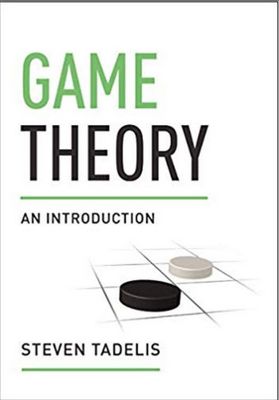Game Theory: An Introduction

Námskeið
-
V-332-AGTH Hagnýt leikjafræði
Lýsing:
The definitive introduction to game theory This comprehensive textbook introduces readers to the principal ideas and applications of game theory, in a style that combines rigor with accessibility. Steven Tadelis begins with a concise description of rational decision making, and goes on to discuss strategic and extensive form games with complete information, Bayesian games, and extensive form games with imperfect information.
He covers a host of topics, including multistage and repeated games, bargaining theory, auctions, rent-seeking games, mechanism design, signaling games, reputation building, and information transmission games. Unlike other books on game theory, this one begins with the idea of rationality and explores its implications for multiperson decision problems through concepts like dominated strategies and rationalizability.
Only then does it present the subject of Nash equilibrium and its derivatives. Game Theory is the ideal textbook for advanced undergraduate and beginning graduate students. Throughout, concepts and methods are explained using real-world examples backed by precise analytic material. The book features many important applications to economics and political science, as well as numerous exercises that focus on how to formalize informal situations and then analyze them.
Introduces the core ideas and applications of game theory Covers static and dynamic games, with complete and incomplete information Features a variety of examples, applications, and exercises Topics include repeated games, bargaining, auctions, signaling, reputation, and information transmission Ideal for advanced undergraduate and beginning graduate students Complete solutions available to teachers and selected solutions available to students.
Annað
- Höfundur: Steven Tadelis
- Útgáfudagur: 2013-01-10
- Blaðsíður: 416
- Hægt að prenta út 2 bls.
- Hægt að afrita 2 bls.
- Format:Page Fidelity
- ISBN 13: 9781400845958
- Print ISBN: 9780691129082
- ISBN 10: 1400845955
Efnisyfirlit
- GAME THEORY
- Title
- Copyright
- Contents
- Preface
- PART I Rational Decision Making
- Chapter 1 The Single-Person Decision Problem
- 1.1 Actions, Outcomes, and Preferences
- 1.1.1 Preference Relations
- 1.1.2 Payoff Functions
- 1.2 The Rational Choice Paradigm
- 1.4 Exercises
- 1.3 Summary
- 1.1 Actions, Outcomes, and Preferences
- Chapter 2 Introducing Uncertainty and Time
- 2.1 Risk, Nature, and Random Outcomes
- 2.1.1 Finite Outcomes and Simple Lotteries
- 2.1.2 Simple versus Compound Lotteries
- 2.1.3 Lotteries over Continuous Outcomes
- 2.2 Evaluating Random Outcomes
- 2.2.1 Expected Payoff: The Finite Case
- 2.2.2 Expected Payoff: The Continuous Case
- 2.2.3 Caveat: It’s Not Just the Order Anymore
- 2.2.4 Risk Attitudes
- 2.2.5 The St. Petersburg Paradox
- 2.3 Rational Decision Making with Uncertainty
- 2.3.1 Rationality Revisited
- 2.3.2 Maximizing Expected Payoffs
- 2.4 Decisions over Time
- 2.4.1 Backward Induction
- 2.4.2 Discounting Future Payoffs
- 2.5 Applications
- 2.5.1 The Value of Information
- 2.5.2 Discounted Future Consumption
- 2.6 Theory versus Practice
- 2.7 Summary
- 2.8 Exercises
- 2.1 Risk, Nature, and Random Outcomes
- Chapter 1 The Single-Person Decision Problem
- Chapter 3 Preliminaries
- 3.1 Normal-Form Games with Pure Strategies
- 3.1.1 Example: The Prisoner’s Dilemma
- 3.1.2 Example: Cournot Duopoly
- 3.1.3 Example: Voting on a New Agenda
- 3.2 Matrix Representation: Two-Player Finite Game
- 3.2.1 Example: The Prisoner’s Dilemma
- 3.2.2 Example: Rock-Paper-Scissors
- 3.3 Solution Concepts
- 3.3.1 Assumptions and Setup
- 3.3.2 Evaluating Solution Concepts
- 3.3.3 Evaluating Outcomes
- 3.4 Summary
- 3.5 Exercises
- 3.1 Normal-Form Games with Pure Strategies
- Chapter 4 Rationality and Common Knowledge
- 4.1 Dominance in Pure Strategies
- 4.1.1 Dominated Strategies
- 4.1.2 Dominant Strategy Equilibrium
- 4.1.3 Evaluating Dominant Strategy Equilibrium
- 4.2 Iterated Elimination of Strictly Dominated Pure Strategies
- 4.2.1 Iterated Elimination and Common Knowledge of Rationality
- 4.2.2 Example: Cournot Duopoly
- 4.2.3 Evaluating IESDS
- 4.3 Beliefs, Best Response, and Rationalizability
- 4.3.1 The Best Response
- 4.3.2 Beliefs and Best-Response Correspondences
- 4.3.3 Rationalizability
- 4.3.4 The Cournot Duopoly Revisited
- 4.3.5 The “p-Beauty Contest”
- 4.3.6 Evaluating Rationalizability
- 4.4 Summary
- 4.5 Exercises
- 4.1 Dominance in Pure Strategies
- Chapter 5 Pinning Down Beliefs: Nash Equilibrium
- 5.1 Nash Equilibrium in Pure Strategies
- 5.1.1 Pure-Strategy Nash Equilibrium in a Matrix
- 5.1.2 Evaluating the Nash Equilibria Solution
- 5.2 Nash Equilibrium: Some Classic Applications
- 5.2.1 Two Kinds of Societies
- 5.2.2 The Tragedy of the Commons
- 5.2.3 Cournot Duopoly
- 5.2.4 Bertrand Duopoly
- 5.2.5 Political Ideology and Electoral Competition
- 5.3 Summary
- 5.4 Exercises
- 5.1 Nash Equilibrium in Pure Strategies
- Chapter 6 Mixed Strategies
- 6.1 Strategies, Beliefs, and Expected Payoffs
- 6.1.1 Finite Strategy Sets
- 6.1.2 Continuous Strategy Sets
- 6.1.3 Beliefs and Mixed Strategies
- 6.1.4 Expected Payoffs
- 6.2 Mixed-Strategy Nash Equilibrium
- 6.2.1 Example: Matching Pennies
- 6.2.2 Example: Rock-Paper-Scissors
- 6.2.3 Multiple Equilibria: Pure and Mixed
- 6.3 IESDS and Rationalizability Revisited
- 6.4 Nash’s Existence Theorem
- 6.5 Summary
- 6.6 Exercises
- 6.1 Strategies, Beliefs, and Expected Payoffs
- Chapter 7 Preliminaries
- 7.1 The Extensive-Form Game
- 7.1.1 Game Trees
- 7.1.2 Imperfect versus Perfect Information
- 7.2 Strategies and Nash Equilibrium
- 7.2.1 Pure Strategies
- 7.2.2 Mixed versus Behavioral Strategies
- 7.2.3 Normal-Form Representation of Extensive-Form Games
- 7.3 Nash Equilibrium and Paths of Play
- 7.4 Summary
- 7.5 Exercises
- 7.1 The Extensive-Form Game
- Chapter 8 Credibility and Sequential Rationality
- 8.1 Sequential Rationality and Backward Induction
- 8.2 Subgame-Perfect Nash Equilibrium: Concept
- 8.3 Subgame-Perfect Nash Equilibrium: Examples
- 8.3.1 The Centipede Game
- 8.3.2 Stackelberg Competition
- 8.3.3 Mutually Assured Destruction
- 8.3.4 Time-Inconsistent Preferences
- 8.4 Summary
- 8.5 Exercises
- Chapter 9 Multistage Games
- 9.1 Preliminaries
- 9.2 Payoffs
- 9.3 Strategies and Conditional Play
- 9.4 Subgame-Perfect Equilibria
- 9.5 The One-Stage Deviation Principle
- 9.6 Summary
- 9.7 Exercises
- Chapter 10 Repeated Games
- 10.1 Finitely Repeated Games
- 10.2 Infinitely Repeated Games
- 10.2.1 Payoffs
- 10.2.2 Strategies
- 10.3 Subgame-Perfect Equilibria
- 10.4 Application: Tacit Collusion
- 10.5 Sequential Interaction and Reputation
- 10.5.1 Cooperation as Reputation
- 10.5.2 Third-Party Institutions as Reputation Mechanisms
- 10.5.3 Reputation Transfers without Third Parties
- 10.6 The Folk Theorem: Almost Anything Goes
- 10.7 Summary
- 10.8 Exercises
- Chapter 11 Strategic Bargaining
- 11.1 One Round of Bargaining: The Ultimatum Game
- 11.2 Finitely Many Rounds of Bargaining
- 11.3 The Infinite-Horizon Game
- 11.4 Application: Legislative Bargaining
- 11.4.1 Closed-Rule Bargaining
- 11.4.2 Open-Rule Bargaining
- 11.5 Summary
- 11.6 Exercises
- Chapter 12 Bayesian Games
- 12.1 Strategic Representation of Bayesian Games
- 12.1.1 Players, Actions, Information, and Preferences
- 12.1.2 Deriving Posteriors from a Common Prior: A Player’s Beliefs
- 12.1.3 Strategies and Bayesian Nash Equilibrium
- 12.2 Examples
- 12.2.1 Teenagers and the Game of Chicken
- 12.2.2 Study Groups
- 12.3 Inefficient Trade and Adverse Selection
- 12.4 Committee Voting
- 12.5 Mixed Strategies Revisited: Harsanyi’s Interpretation
- 12.6 Summary
- 12.7 Exercises
- 12.1 Strategic Representation of Bayesian Games
- Chapter 13 Auctions and Competitive Bidding
- 13.1 Independent Private Values
- 13.1.1 Second-Price Sealed-Bid Auctions
- 13.1.2 English Auctions
- 13.1.3 First-Price Sealed-Bid and Dutch Auctions
- 13.1.4 Revenue Equivalence
- 13.2 Common Values and the Winner’s Curse
- 13.3 Summary
- 13.4 Exercises
- 13.1 Independent Private Values
- Chapter 14 Mechanism Design
- 14.1 Setup: Mechanisms as Bayesian Games
- 14.1.1 The Players
- 14.1.2 The Mechanism Designer
- 14.1.3 The Mechanism Game
- 14.2 The Revelation Principle
- 14.3 Dominant Strategies and Vickrey-Clarke-Groves Mechanisms
- 14.3.1 Dominant Strategy Implementation
- 14.3.2 Vickrey-Clarke-Groves Mechanisms
- 14.4 Summary
- 14.5 Exercises
- 14.1 Setup: Mechanisms as Bayesian Games
- Chapter 15 Sequential Rationality with Incomplete Information
- 15.1 The Problem with Subgame Perfection
- 15.2 Perfect Bayesian Equilibrium
- 15.3 Sequential Equilibrium
- 15.4 Summary
- 15.5 Exercises
- Chapter 16 Signaling Games
- 16.1 Education Signaling: The MBA Game
- 16.2 Limit Pricing and Entry Deterrence
- 16.2.1 Separating Equilibria
- 16.2.2 Pooling Equilibria
- 16.3 Refinements of Perfect Bayesian Equilibrium in Signaling Games
- 16.4 Summary
- 16.5 Exercises
- Chapter 17 Building a Reputation
- 17.1 Cooperation in a Finitely Repeated Prisoner’s Dilemma
- 17.2 Driving a Tough Bargain
- 17.3 A Reputation for Being “Nice”
- 17.4 Summary
- 17.5 Exercises
- Chapter 18 Information Transmission and Cheap Talk
- 18.1 Information Transmission: A Finite Example
- 18.2 Information Transmission: The Continuous Case
- 18.3 Application: Information and Legislative Organization
- 18.4 Summary
- 18.5 Exercises
- Chapter 19 Mathematical Appendix
- 19.1 Sets and Sequences
- 19.1.1 Basic Definitions
- 19.1.2 Basic Set Operations
- 19.2 Functions
- 19.2.1 Basic Definitions
- 19.2.2 Continuity
- 19.3 Calculus and Optimization
- 19.3.1 Basic Definitions
- 19.3.2 Differentiation and Optimization
- 19.3.3 Integration
- 19.4 Probability and Random Variables
- 19.4.1 Basic Definitions
- 19.4.2 Cumulative Distribution and Density Functions
- 19.4.3 Independence, Conditional Probability, and Bayes’ Rule
- 19.4.4 Expected Values
- 19.1 Sets and Sequences
UM RAFBÆKUR Á HEIMKAUP.IS
Bókahillan þín er þitt svæði og þar eru bækurnar þínar geymdar. Þú kemst í bókahilluna þína hvar og hvenær sem er í tölvu eða snjalltæki. Einfalt og þægilegt!Rafbók til eignar
Rafbók til eignar þarf að hlaða niður á þau tæki sem þú vilt nota innan eins árs frá því bókin er keypt.
Þú kemst í bækurnar hvar sem er
Þú getur nálgast allar raf(skóla)bækurnar þínar á einu augabragði, hvar og hvenær sem er í bókahillunni þinni. Engin taska, enginn kyndill og ekkert vesen (hvað þá yfirvigt).
Auðvelt að fletta og leita
Þú getur flakkað milli síðna og kafla eins og þér hentar best og farið beint í ákveðna kafla úr efnisyfirlitinu. Í leitinni finnur þú orð, kafla eða síður í einum smelli.
Glósur og yfirstrikanir
Þú getur auðkennt textabrot með mismunandi litum og skrifað glósur að vild í rafbókina. Þú getur jafnvel séð glósur og yfirstrikanir hjá bekkjarsystkinum og kennara ef þeir leyfa það. Allt á einum stað.
Hvað viltu sjá? / Þú ræður hvernig síðan lítur út
Þú lagar síðuna að þínum þörfum. Stækkaðu eða minnkaðu myndir og texta með multi-level zoom til að sjá síðuna eins og þér hentar best í þínu námi.
Fleiri góðir kostir
- Þú getur prentað síður úr bókinni (innan þeirra marka sem útgefandinn setur)
- Möguleiki á tengingu við annað stafrænt og gagnvirkt efni, svo sem myndbönd eða spurningar úr efninu
- Auðvelt að afrita og líma efni/texta fyrir t.d. heimaverkefni eða ritgerðir
- Styður tækni sem hjálpar nemendum með sjón- eða heyrnarskerðingu
- Gerð : 208
- Höfundur : 8749
- Útgáfuár : 2013
- Leyfi : 379


